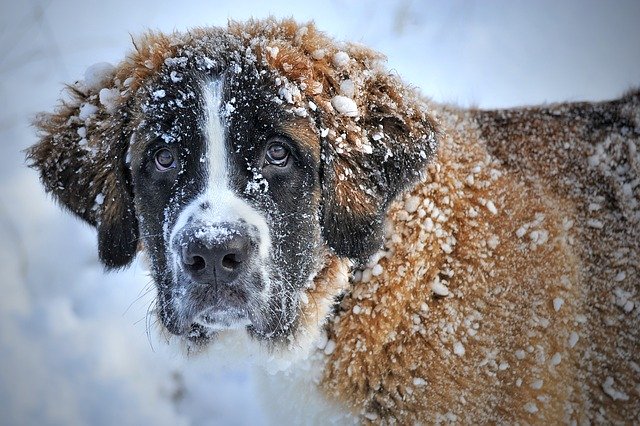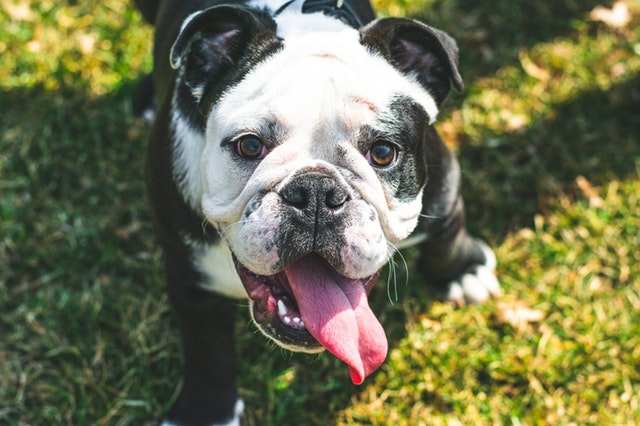Past weeks I got many questions about different topics related to dogs. As a dog owner, you can’t stop yourself from asking yourself different queries related to their health. The most common questions are “What is cancer in dogs” and ” What are the symptoms of cancer in dogs.”
Yes, we all worry about our fluffy friends. However, you must be ready to help them whenever they need your help. Our dogs, just like babies, are cute and energetic, but they are easy to catch dangerous diseases and life-threatening conditions.
Cancer in dogs is one of the leading causes of death in dogs over the age of 10. That alone gives you a reason to know all the information about cancer. Why? Simply to protect your dog from further damage to the body and to treat it as soon as possible.
Fortunately, half of all dog cancers are curable if caught in an early stage. Also, it is estimated that 1 in 3 domestic dogs will develop cancer.
Got your attention? Good! Keep reading and protect your dog!
To answer the question of what is cancer in dogs, we must know what causes cancer in dogs and all the signs of cancer in dogs. When we are talking about cancer in dogs, then we are talking about different types of cancers in dogs. Dogs can develop different types of cancer, the same as humans. Also, experts described them with the same terminology and used the same classification systems, including:
- Mast cell tumors (the most common type of skin cancer in dogs)
- Prostate cancer
- Lymphoma
- Brain cancer
- Others
Before we get into more details about the symptoms of cancer in dogs, let’s get familiar with what causes cancer in dogs, after all, that’s an important thing to know to protect our fluffy friends.

Table of Contents
What Causes Cancer In Dogs?
Cancer is a complex disease. It is also a multifactorial one, which means many factors may lead to cancer cell formation within the body—carcinogenesis (the initiation of cancer formation) is associated with chromosomal translocations, DNA mutations, aberrant cell cycle regulators and dysfunctional proteins.
Cancer reconstructs the DNA of the body cells, and the mutated genetic elements are passed on to daughter cells, resulting in what it is called neoplasms.
The mutated DNA affects genes involved with the cell cycle, classified as either oncogene (a gene which in certain circumstances can transform a cell into a tumor cell.) or tumor suppressor genes.
Oncogenes are responsible for cell reproduction and differentiation. Also, Oncogenes accountable for cell growth are shown as cancerous cells.
Now, to protect the body’s cells from erroneous cell cycles from replicating, we need tumor suppressor genes. As for cancer cells, they ignore cell cycle regulators that control cell division, growth, and death.
As you can notice, many factors are explaining the answer to what causes cancer in dogs. Also, there are other factors attributed to spontaneous cancer formation (spontaneous tumorigenesis). The causes and factors of its development include inherited epigenetic and environmental factors.
Another vital factor to consider is your dog breed. Certain breeds of dogs are at higher risk of developing specific cancers. Knowing your dog breeds and which cancer they may develop is a good thing to protect your dog and improve its lifestyle to avoid it.
What causes cancer in dogs? After going through all these factors, we can understand now that cancer in dogs is a complex multifactorial disease. Also, for specific types of cancers, age and sex can play a huge role.
As dog owners, we all made sure to give our fluffy friends the best life they need, therefore, dogs now live longer than before, and that is a significant factor to witness our dogs suffering from cancers.
Why? Because before dogs died from other common causes and diseases. But now, we managed to take care of them even better with a good health care system as well as producing vaccines to protect them.

Types Of Cancer In Dogs
There are different types of cancer in dogs, the same as humans. Unlike other animals, dogs are susceptible to develop the same types of cancer as us. In recent studies, around 50% of dogs over the age of 10 develop cancer at some point in their life.
Fortunately, most of the cancers in dogs are treatable if it is diagnosed in its early stage. So, it is your job as a dog owner to pay attention to your senior dog and take care of it.
The most common types of cancer in dogs are:
12. Hemangiosarcoma:
Unfortunately, This type of cancer in dogs is incurable, which affects the cells that line the blood vessels. Although it is more common for senior dogs to develop cancer, this type occurs more commonly in middle-aged or elderly dogs.
Also, specific breeds of dogs are at higher risk of developing this type of cancer, including German Shepherds and Golden Retrievers. Because of that, it is recommended by experts for additional screening after the age of 5 for these breeds.
Note that less than fifty percent of treated dogs survive more than six months, and many of these dogs die from severe internal bleeding before there is an opportunity to begin treatment.
11. Lymphoma:
Lymphoma is one of the different types of cancer in dogs that affect any dog breed at any age. As the name suggests, it affects the lymph nodes, and most of the time it appears as swollen glands that can both felt or seen in their anatomical areas (under the neck, in front of shoulders or behind the knee).
Furthermore, lymphoma can affect the lymph nodes that are inside the body, which is not visible from the outside, such as lymph nodes in the abdomen or chest. Fortunately, This type of cancer in dogs is considered treatable in its early stage. Also, you must know that different dog breeds at higher risk than others include Australian Shepherds, Standard Poodles, and Golden Retrievers.

10. Mast Cell Tumors:
Some types of cancer in dogs developed from the immune cells inside the body. Mast cells are known to be immune cells responsible for allergies. Also, you can find mast cells in all tissues of the body.
However, they form tumors on the skin in around 20% in the dog population. Plus, They can be either relatively benign to extremely aggressive.
Additionally, specific breeds of dogs are at higher risk of developing this tumor, which indicates that genetics is the main factor to cause it. An example of such breeds is Boxers are uniquely predisposed to this type of cancer.
9. Bladder Cancer:
This type of cancer developed slowly in dogs, and the symptoms may not show for 3-6 months. Also, Some breeds are at a higher risk for this type of cancer than others.
8. Osteosarcoma:
This type of dog cancer is the most common type of bone cancer in dogs (primary bone cancer), which is up to 85% of tumors originate in the skeletal system. Also, it can affect any age or size. However, it is more common in older large breeds.
Osteosarcoma can affect any bone in any area of the body. However, it most commonly affects the bones in the shoulder, knee, and wrist.
7. Malignant Histiocytosis:
This is a hereditary disease that affects large breeds mostly. It is seen as localized lesions in different areas of the body, such as the lymph nodes, spleen, lung, skin, brain, bone marrow, large limb joints (appendicular joints).
Histiocytic sarcoma may also occur as multiple lesions in single organs such as the spleen, and rapidly distribute to involve various organs. Sadly, there is no effective treatment for this type.

6. Brain Tumors:
Brain tumors can be obvious with their symptoms, such as epileptic-like seizures or other drastic behavioral changes you may see on your dog.
Usually, they are only clinical signs. However, your veterinarian may perform CAT ( CT or computerized axial tomography) scanning, and MRI to determine the size, location, and severity of the brain tumor.
This tumor can be either operable (Surgical intervention may be suggested to remove the tumor) or inoperable (which can be treated using oral chemotherapy and radiation to control the tumor).
5. Mammary Carcinoma:
This type of cancer affects most non-spayed female dogs as they are at higher risk for developing malignant mammary tumors. However, all-female dogs, regardless of non-spayed or not, remain at risk.
Roughly fifty percent of these tumors are malignant. Your veterinarian will recommend a complete surgical removal if cancer has not metastasized.
4. Testicular Cancer:
Fortunately, this type of cancer is preventable by neutering and curable with surgery in its early stage. This type affects and more common in unneutered dogs with retained testes.
3. Mouth And Nose Cancer:
This is another very common type of cancer in dogs. This cancer is more common in the mouth than that in the nose. The symptoms vary depending on the site of cancer include bleeding, different odor, difficulty eating, mass on the gums.
Cancer in the nose may develop from the inside, which causes breathing difficulty, bleeding, and/or facial swelling.
2. Melanoma:
Melanoma is commonly affecting dogs with dark skin, this type of cancer that develops from the pigment-producing cells known as melanocytes, which are responsible for coloring the skin.
Melanoma can be seen as small, dark lumps (brown to black), but they can also appear as large, flat, wrinkled masses. Melanoma can be seen in areas of haired skin.
Unfortunately, malignant melanoma, which manifests in the mouth or the distal limbs (usually the toenail beds), is an incurable disease. These malignant tumors are diagnosed late and have very often spread to distant parts of the body by the time they are diagnosed, making complete surgical removal difficult and inoperable.
1. Squamous Cell Carcinoma:
This type of cancer in dogs is most often found in the mouth and the nail beds of the toes. Early detection is essential, and complete surgical removal is the treatment of choice.
Less than 20% of dogs develop metastatic disease. Also, the most aggressive part of squamous cell carcinoma in tonsils and tongue and less than 10% of the affected dogs survive one year or longer despite treatment measures.

Signs And Symptoms Of Cancer In Dogs
After going through all the types of cancer in dogs, it is easier now to answer part of our question for today of what is cancer in dogs. As we can see, there are many types of cancer in dogs that may develop and affect our dogs’ health. However, it is vital to know all of the signs and symptoms of cancer in dogs.
There are indeed many symptoms of cancer in dogs depending on the type, but knowing the most common symptoms is essential to prevent cancer in dogs.
Common symptoms of cancer in dogs:
- Weight Loss: If you notice your dog losing weight despite a good appetite, that’s one of the alarming symptoms of cancer in dogs. So, monitor your dog overall health; noticing unexplained weight loss is a good sign for you to take it to your veterinarian for a check-up.
- Loss of appetite: Senior dogs may not eat as much as they used to be when they were younger. However, there is still a regular healthy eating habit. Loss of appetite is one of the crucial signs of cancer in dogs or another illness. As a dog owner, once you notice this, you must take your dog for a check-up.
- Sores that don’t heal: Having sores is acceptable. However, if your dog has sores that don’t heal properly or not at all, that can be one of the symptoms of cancer in dogs or another illness such as infection.
- Abnormal swellings, lumps, or bumps: Your dog can get swelling or lump for any reason, but if this swelling persists or continue to get larger, then it is an alarming sign that there is a problem causing it. The swelling can be seen anywhere on the body of your dog. Therefore, a regular and thorough examination is required to discover this as early as possible.
- Difficulties of breathing: This symptom can be seen in many different diseases and conditions. Once you notice this issue, you must contact your veterinarian immediately for further diagnosis and management.
- Going to the bathroom very often: Another symptom that can indicate different diseases, especially urinary tract diseases and infection, which requires your veterinarian attention and investigation.
- Limping, stiffness, or continuing lameness: Any of these signs can be seen and caused by muscle, nerve, or bone cancer. However, in senior dogs, it can also be seen as a symptom of arthritis.
- Difficulties with eating or swallowing are common signs of cancers in dogs, which affects the mouth and neck.
- Discharges: Noticing any discharge indicate a problem in the body, such as bleeding, vomiting, and diarrhea. These can be seen in many diseases that share the same symptoms. However, if these symptoms persist, that may indicate there is a severe problem that requires a proper investigation and diagnosis.
- Unwillingness to exercise and play (Decrease in stamina): Although the cause for this condition can be as simple as your dog being old age, it can also be one of the first pointers that your dog is sick.
- Bad odor: Bad odor can be a common sign of cancer in dogs. The presence of cancer in the mouth, nose, or anus can lead to these offensive smells.

How To Prevent Cancer In Dogs
As a dog owner, you must be wondering how to prevent cancer in dogs. This question has been asked by many. The essential step to protect your dog is spaying your dog. Spay a dog before its first heat is a huge step to reduce the chance of mammary cancer 8-fold, simply because of the hormonal influence.
Also, good nasal and oral care can help decrease cancer in their mouth and nose. And if you are planning to buy a purebred dog, make sure to check its line to see if there’s a specific type of cancer in that breed’s line. That will help you to suspect it and help your veterinarian for early diagnosis.
Another good step is to make sure of giving your dog an excellent healthy food and avoid any chemical components. But overall, complete prevention can be challenging to achieve, simply because we don’t know all the causes of cancers in dogs.
Prevention here merely is helping yourself and your dog to diagnose and identify cancer as early and quickly as possible for better treatment and management.
Treatment Of Cancer In Dogs
Treatment of cancer in dogs depends on many factors. Therefore, your veterinarian will consider the following factors before starting any treatment of cancer in dogs:
- Tumor type
- The biological behavior of the tumor
- Age of the dog
- The general health of the dog
- The Stage of the Cancer
The same as in humans, the overall health status plays a massive role in therapy options for dogs with cancer. Your veterinarian will begin by evaluating the dog’s ability to tolerate cancer therapy.
Also, they will consider the life expectancy as well; for a slow-growing tumor in an older dog, for example, treatment disadvantages may outweigh potential benefits.
Treatment of cancer in dogs are similar to human therapies, which can include:
- Surgery
- Chemotherapy
- Radiation therapy
- Holistic or herbal therapy
- Immunotherapy in the form of an anti-cancer vaccination to strengthen the immune system against invading tumor cells
- Stem cell transplants in dogs who have been diagnosed with blood cancers
Choosing only one course of treatment or multiple treatment options combined is controversial between experts. Depending on the case and other factors, sometimes combining methods work well for dogs with cancer, but that may not always be the case as some treatments may interfere with each other and potentially cause unintended harm.

Conclusion
Whether you own a dog or planning to buy a specific breed of dogs, answering the question of what is cancer in dogs is as important! Our time changed, and dogs can face different diseases. Some diseases are common, and they have proper treatment. But, other diseases are still unknown causes, and therefore it is difficult for us to cure it completely.
Prevention is the key to prevent cancer in dogs but not entirely as it is a big challenge to prevent cancer in dogs 100%. However, knowing all the signs and symptoms of cancer in dogs can help your dog to identify cancer as early and quickly as possible, which is vital for a better prognosis after the treatment.
Your dog is your family, so make sure always to pay attention to them and their behavior. They are like babies, they can’t talk or complain, but they will show you obvious symptoms and signs that they are suffering from pain or illness.
So finally, I hope you found this article (What is cancer in dogs) useful and informative. Let me know your answer down below. What do you think about cancer in dogs? Do you have more information or tips about canine cancers or how to prevent its complications? Write them down below.
If you have any other questions or different opinions about it, leave a comment below.
Today’s Quote:
“Dogs do speak, but only to those who know how to listen!” — Orhan Pamuk
You’ll Also Love These Posts:
Studies have shown if you like this blog article — you will also love the following posts.

